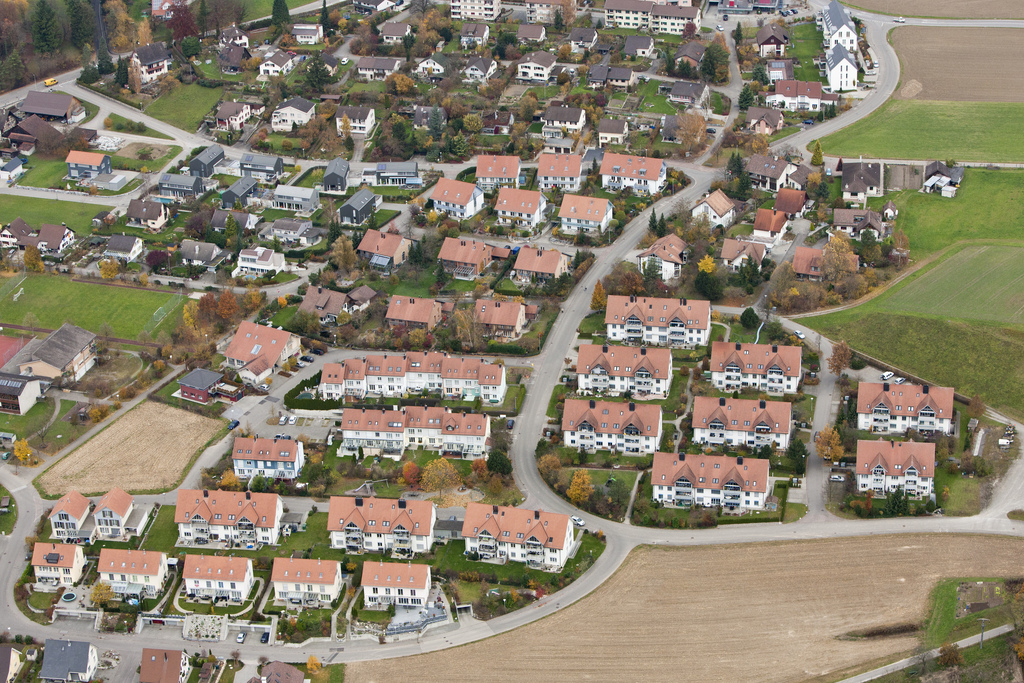Tug of war over scarce building areas

Who can build what where in Switzerland? On March 3 voters finally go to the polls – after years of heated debate – to have their say on efforts to tighten the federal law on land use.
They will be voting on a government counterproposal to an initiative – since withdrawn – which had demanded that the total area of building land may not be expanded over the next 20 years.
Instead, the revised law aims to restrict the accepted reserves of building plots in the cantons, which, along with communes, would be obliged to reduce plots and compensate their owners.
Environmentalists say urban sprawl is damaging the countryside while business-minded opponents are concerned by additional levies, the challenge of rezoning and fears that the cantons would lose competencies to the government.
The roots of this political maze go back to 2005, when Amgen, the American biotechnology giant, wanted to build an industrial complex on a greenfield site that also happened to be Switzerland’s most important piece of farmland.
The project in canton Fribourg did not materialise, but the land-use initiative was born. Environmental organisation Pro Natura has for some time been vexed about the unsatisfactory implementation of existing spatial planning regulations.
The 1980 law obliges cantons to regulate the settlement development, but most of the cantons did not really implement the proposed measures. That is why the initiative demanded that the total area of building land may not be expanded over the next two decades.
Pro Natura whipped up support with various parties and in the end managed to get a broad coalition to back its cause. The backers of the initiative, Space for People and Nature (land-use initiative), collected 109,422 signatures in 2008, enough to force a nationwide vote.
The following parties and organisations support the legislative amendment (effective January 2013):
Social Democrats, Green Party, Green-Liberal Party, Pro Natura, Swiss Association for Spatial Planning, Swiss Cities Association.
The following parties and organisation are against the revised spatial planning law:
Swiss People’s Party, Swiss Trade Association, Swiss Home Owners’ Association, Swiss Real Estate Association, Swiss Automobile Trade Association.
Parliament approved the revised spatial planning law with 108 to 77 votes with ten abstentions in the House of Representatives and 30 to ten votes with one abstention in the Senate.
Spatial planning law
Consequently, the government decided to make an indirect counterproposal through a partial revision of the existing spatial planning law to try to take the wind out of the sails of the initiative supporters. After some debate, parliament eventually approved the government’s proposal in the summer of 2012.
This convinced the coalition behind the initiative to withdraw it. It will only come to a vote if the change in law is rejected.
But the Swiss Trade Association was not happy with the proposed legislation amendment approved by parliament and forced a referendum with 69,277 valid signatures. Hence, the people will have their final say on the change in law.
The revised law aims to restrict the accepted reserves of building plots in the cantons. The cantons and the communes would be obliged to reduce plots, which were previously measured too generously, and to compensate their owners.
Proprietors whose land is rezoned to their advantage have to pay a levy of at least 20 per cent on the increase in value, should their plot be sold or developed. In addition, the state is able to oblige owners to develop their parcel of land within a certain time limit – under threat of sanctions.
Is compact building enough?
“Swiss spatial planning policy is not sustainable at all,” said Beat Jans from the centre-left Social Democratic Party. Jans is in favour of the revised change of law.
“We’re destroying the Swiss landscape. We construct too much, in the wrong areas and the wrong things. We need to change something urgently.”
The legislative amendment would give the cantons the necessary instruments so that they can be “obliged to observe the law”, he said. In concrete terms, the amendment provides that fewer building areas would be excluded and that contractors would have to build more densely.
This is a point with which opponents, including Jean-François Rime of the rightwing People’s Party and president of the Swiss Trade Association, agree. His association campaigns for a revival of village and town centres.
Compact building does, however, have its limitations, Rime added. Over the next 20 years, the number of Swiss residents will increase from 8 million to 9.5 million.
“Taller buildings and the renovation of old structures will not be enough to house an additional 1.5 million people,” he explained.

More
“We probably build too much in this country”
Several battle fields
The Swiss Trade Association is opposed to the amendment for three concrete reasons, Rime said.
“First of all, the cantons will have to rezone 180 square kilometres of plots. That’s a huge area. Secondly, the law provides for an obligation to build, so somebody with land reserves could be forced to build. And thirdly, there would be another levy on the surplus value, which means another kind of tax.”
The levy is already laid down in existing legislation, Jans retorts. And it is only “more than right that people who become millionaires overnight will have to put aside part of their money for spatial zoning and [the preservation] of the countryside.”
“These receipts would not even be enough to finance such revertive zoning,” Rime replied, adding that the levy was not the weakest point of the revision, but rather the rezoning and the obligation to build. These coercive land-law measures would in his opinion lead to a further shortage of building areas.
Switzerland has “about three times the building plots it will actually need until 2030”, according to Jans. As a result, we cannot really build where “we should ideally build”.
With the legislative amendment the cantons would only be able to demand that certain building projects would have to be completed quicker and that the building area would otherwise be rezoned.
Assault on federalism?
Finally, opponents fear that because of the revised law the cantons would lose some competencies to the government.
“If there is a subject where federalism is working one hundred per cent, then it is spatial planning,” Rime said.
“Communes and cantons know the local conditions and may also decide themselves what they want and what they don’t want.”
There is no shift of competences, according to Jans. “A rejection of the spatial planning law, however, would automatically engender a vote on the land-use initiative, which would clearly shift competencies.”
He prefers the counterproposal, but said he would “vehemently take a stand for the initiative, should the legislative amendment be rejected.”
Of the total 69,000 valid signatures against the spatial planning law, almost 32,000 are from canton Valais.
The canton, which heavily relies on tourism, has the largest area of building plots per capita as well as the largest share of developable surfaces, so-called building reserves, according to the Federal Office for Spatial Planning. That is why the canton would be particularly affected by the revision.
The opposition increased further after the people on March 11, 2012, approved the limitation of the spread of holiday homes.
The canton also considered initiating a cantonal referendum, which would allow at least eight cantons to force a popular vote on a federal law, but no other canton was prepared to join canton Valais.
In October 2008, the Federal Office for Spatial Planning published the first statistics on the developable areas in Switzerland. The office found that there is an “unabated trend for an increased use of space” in the whole of Switzerland.
The building land reserves could accommodate between 1.4 million and 2.1 million people and are – in view of the population development – too large and are often in the wrong area, the office found.
(Adapted from German by Chantal Britt)

In compliance with the JTI standards
More: SWI swissinfo.ch certified by the Journalism Trust Initiative

You can find an overview of ongoing debates with our journalists here. Please join us!
If you want to start a conversation about a topic raised in this article or want to report factual errors, email us at english@swissinfo.ch.